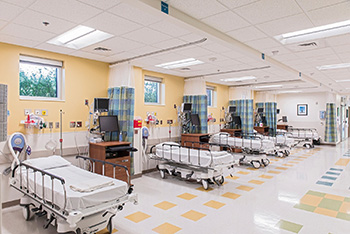LEDs Reduce Costs, Boost Patient Satisfaction
 DURHAM, N.C. — The around-the-clock nature of hospitals can make lighting an expensive technology, which is why conserving energy and finding low-cost alternatives is especially important.
DURHAM, N.C. — The around-the-clock nature of hospitals can make lighting an expensive technology, which is why conserving energy and finding low-cost alternatives is especially important.
Health care organizations spend more than $6.5 billion on energy each year to meet patient needs, according to the Environmental Protection Agency (EPA). For every dollar a nonprofit health care organization can save on energy, it will generate $20 of revenue for hospitals or $10 for medical offices.
Lighting takes up a large portion of a hospital’s energy use, consuming more than 10 percent. Lighting also increases the demand for cooling because electricity generates heat. In 2011, the Department of Energy published a fact sheet on ways hospitals can reduce their operations costs through lighting. The department pointed to LEDs as a lamp technology with a quick pay-off.
LEDs use less than one-third of the energy consumed by fluorescents and seven times less than incandescents, according to the Department of Energy. They also require less maintenance and increase safety with higher lumen outputs and contrasts against backgrounds. For a typical 600-bed hospital with 300 exit signs, replacing traditional 36-watt signs with 5-watt LED signs would result in an annual savings of roughly $14,000, according to the department’s research.
At the Raleigh Orthopaedic Clinic in Raleigh, N.C., 1,000 LED troffers — light fixtures that fit into a ceiling grid — are helping to decrease energy usage by 54 percent. The clinic worked with Cree, an LED manufacturer based in Durham, to install the LEDs in their new 98,000-square-foot headquarters and surgery center. The facility, designed by GMK Associates of Columbia, S.C., opened in November 2013.
“I think the challenge that a lot of our customers have is figuring out how to maximize the use of limited budgets,” said Dave VanSpybrook, director of sales enablement at Cree. “Lighting is a huge component of any facility’s energy consumption. As companies become aware of technology like LED, what they’re trying to figure out is whether it can help them meet their goals for lower energy expenditures and lower maintenance costs.”
Lighting doesn’t only affect budgets and maintenance — patients also notice it. VanSpybrook noted that patient surveys are becoming more important in the way hospitals design and plan for their facilities.
“Patient surveys can be affected by any kind of perception of the facility — whether [the facility is] high-tech, clean or well-lit. Ensuring patient satisfaction overall is key,” VanSpybrook said. “In health care, what we see is the facility needing to be cutting-edge and the customer wanting it to be cutting-edge. Certain things like dimming and even the color of light can be a big deal in whether the customer perceives it as a modern facility.”
One of the best features of LEDs, according to VanSpybrook, is that they’re inherently a digital technology, which makes things such as lighting controls much more effective. Lighting controls can help mitigate energy usage by dimming or turning off lights in hallways automatically if no one is present. LEDs are also more effective and safer for instant illumination versus traditional fluorescents, which have a slow warm-up period.
Another consideration for health care facilities is the use of LEDs in parking garages.
“[Hospitals] have patients and staff arriving at all hours of the night. LED lighting, or lighting in general, is actually very important from the second that a patient or staff member arrives onto the property. Quality lighting can make sure that the environment is safe,” VanSpybrook said.
